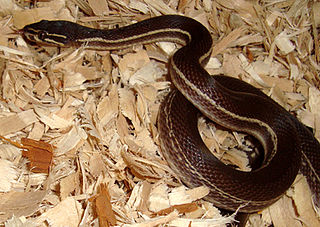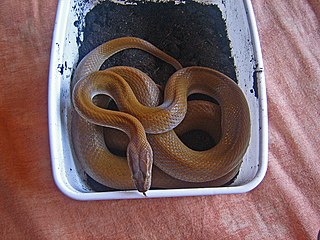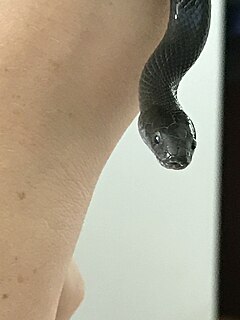
Garter snake is a common name for generally harmless, small to medium-sized snakes belonging to the genus Thamnophis in the family Colubridae. Native to North and Central America, species in the genus Thamnophis can be found from the subarctic plains of Canada to Costa Rica.

Morelia is a genus of large snakes in the family Pythonidae found in Indonesia, New Guinea, and throughout Australia. Currently, up to eight species are recognized.

Drymarchon is a genus of large nonvenomous colubrid snakes, commonly known as indigo snakes or cribos, found in the Southeastern United States, Central America, and South America. Reaching 3 m (9.8 ft) or more in length, they are among the world's largest colubrid snakes.

Oligodon is genus of colubrid snakes that was first described by the Austrian zoologist Fitzinger in 1826. This genus is widespread throughout central and tropical Asia.

The Natricinae are a subfamily of colubroid snakes, sometimes referred to as a family (Natricidae). The subfamily comprises 37 genera. Members include many very common snake species, such as the European grass snakes, and the North American water snakes and garter snakes. Some Old World members of the subfamily are known as keelbacks, because their dorsal scales exhibit strong keeling.
Gonionotophis is a genus of snakes, known commonly as African ground snakes and file snakes, in the family Lamprophiidae. The genus is endemic to Central Africa.
Hormonotus is a genus of snakes. At present, this genus is monotypic, as there is only one commonly accepted species in it, Hormonotus modestus, commonly known as the Uganda house snake or yellow forest snake. It is widespread in tropical Africa. Its sister taxon is Inyoka swazicus, the Swazi rock snake.

The Colubrinae are a subfamily of the family Colubridae of snakes. It includes numerous genera, and although taxonomic sources often disagree on the exact number, The Reptile Database lists 717 species in 92 genera as of September 2019. It is the second largest subfamily of colubrids, after Dipsadinae. Many of the most commonly known snakes are members of this subfamily, including rat snakes, king snakes, milk snakes, vine snakes, and indigo snakes.

The Transvaal grass lizard, also known as the coppery grass lizard and Transvaal snake lizard is a species of lizard in the genus Chamaesaura. It is found in southern African grasslands and on slopes. The Transvaal grass lizard is ovoviparous. The scientific name refers to its copper colour.

The Aurora house snake, Aurora snake, or night snake, Lamprophis aurora, is a species of snake in the family Colubridae. It is endemic to Southern Africa.

Mehelya is a genus name of colubrid snakes from Africa. Some species formerly assigned to the genus Mehelya are now found in the genera Gonionotophis, Gracililima, or Limaformosa. They are collectively called file snakes due to their unusual scalation. They are not venomous.

Lycodonomorphus is a genus of snakes commonly referred to as African water snakes. They are small, nonvenomous snakes, with all members being endemic to Africa, especially Tanzania.

Boaedon is a genus of African lamprophiids consisting of the "brown" house snakes. The genus was originally described by Duméril but the species contained were reclassified as Lamprophis by Fitzinger in 1843, this taxonomy remained widely accepted until November 2010 when a phylogenetic study was published by C.M.R Kelly et al. who resurrected the Boaedon clade. Although commonly regarded as belonging to the Colubridae, primary literature usually lists them, and related species, as belonging to the family Lamprophiidae within the superfamily which includes the venomous cobras and mambas, Elapoidea.

Boaedon lineatus, the striped house snake, is a species of lamprophiid from throughout Africa. This species has a wide range stretching from Tanzania through Central Africa as far as Uganda. They are kept as pets with increasing regularity, often captured and exported for the pet trade. Until November 2010, this species was grouped in the genus Lamprophis, but a paper published by Kelly et al. reclassified this species in the genus Boaedon.

Boaedon capensis, the Cape house snake, also known as the brown house snake, is a species of lamprophiid from Botswana, South Africa, Mozambique, Zambia and Zimbabwe. They are a non-venomous lamprophiid. This species was previously grouped in the genus Lamprophis but is regrouped with the genus Boaedon.

The Lamprophiidae are a family of snakes found mostly in Africa, but also in parts of southern Europe and western Asia. A few species reach southeastern Asia. There are 322 species as of April 2019.

Dipsadinae is a large subfamily of colubroid snakes, sometimes referred to as a family (Dipsadidae). They are found in most of the Americas, including the West Indies, and are most diverse in South America. There are more than 700 species.
Oligodon ancorus, commonly known as the northern short-headed snake, is a species of colubrid snake found on the islands of Luzon and Mindoro in the Philippines, and the island of Sumatra in Indonesia. However, whether the populations from Sumatra, described as Oligodon rhombifer, belong to this species has been contested.

Lamprophiinae is a subfamily of lamprophiid snakes, a large group of mostly African snakes, most of which were formerly classified as colubrids but which we now know are actually more closely related to elapids.

Lycodonomorphus inornatus, commonly known as the olive house snake, the black house snake, and the olive ground snake, is a species of nonvenomous snake in the family Lamprophiidae. The species is endemic to southern Africa. It is a nocturnal snake with terrestrial habits.















